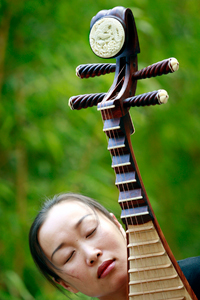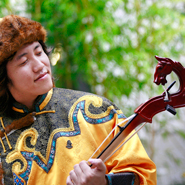Posted: 15 October 2007
UNESCO protected musical masterpieces performed at UCD
Three of China’s four UNESCO Masterpieces of the Oral and Intangible Heritage of Humanity: the traditional folk Long Song, overtone singing and morin khuur (horse-head fiddle) of Mongolia; the qin zither with a history of over 3,000 years; and the mukam song-and-dance music of the Uyghur people of Xinjiang – were performed for the first time ever in Ireland at an open public performance at University College Dublin, Belfield, on 12 October.
The performance was part of the 12th International CHIME conference hosted by the UCD School of Music, in association with the Chester Beatty Library, from 11 – 14 October 2007. The conference included panels, round tables, video sessions, concerts and brief recitals.
Traditional folk Long Song, overtone singing and morin khuur (horse-head fiddle) of Mongolia
Mongolia has a strong tradition of vocal music because of its nomadic lifestyle. Their closeness to nature and animal husbandry has led to the development of amazing vocal styles. Some of the variety of vocal genres found in Mongolia include: the Short Song (Bogino duu); Long Song (Urtiin duu); and overtone singing (khöömii). Short songs contain a wide range of themes and include drinking songs, working songs, lullabies and songs about animals particularly the horse.
The Long Song genre is vocally more demanding and it has long melodic lines embellished by improvisations using trills, glissandos and glottal style yodelling effects.
Khöömii overtone singing is a technique which allows one person to sing two or even three distinct pitches at the same time. The singer utilises the harmonic or overtone series to do this. Khöömii is a magical style of singing found in the central Asian Altai mountain range. It is particularly strong in Western Mongolia, Tuva (which is part of the Russian Federation), the Gorno Altai region, Karkhassia, Baskhiria and the Kalmyk Mongol region by the Volga River.
Due to changing lifestyles and urbanisation, some of these traditional genres are rapidly becoming lost as younger generations of Mongolians are no longer interested in learning them. Since 2005, the Mongolian Long Song has been designated as a UNESCO Masterpiece of Intangible Cultural Heritage of Humanity.
Aruhan (female) – Born in the grasslands of Horqin in Inner Mongolia, Aruhan comes from a family of folk singers. She is a singer of the Short Song (Bogino duu) and Long Song (Urtiin duu). In 2001, she has been a student in the Music College in the Beijing National University, studying Western vocal techniques. She has performed in many countries outside of China.
Alatengwula (male) - Born in Alxa district in Inner Mongolia, Alatengwula graduated in 1997 at the Arts College of Inner Mongolia. In 2006, he completed his musical training in the Beijing National University. Since 2004, he has won numerous awards in the folk style category in various singing competitions. He is an accomplished singer of the Long Song genre.
Anggeiriga (male) – Born in Xilin Gol district in Inner Mongolia, Anggeriga is a performer of the khöömii overtone singing. He studied overtone singing from the khöömii master Audusurong. He performed in Japan in 2007.
Menghedalai (male) – Born in Horqin, Menghedalai is a master player of the Mongolian horse-head fiddle (morin khuur). Apart from the morin khuur, he is also skilled in overtone singing.
Music of the pipa (4-string lute)
Liu Fang was born in 1974 in Kunming in the Chinese province of Yunnan and now living in Montreal. She began studying the pipa at the age of six and gave her first public performance as a pipa soloist when she was nine.

Liu Fang, playing music of the pipa (4-string lute), who gave a public performance at University college Dublin on Friday 12th October 2007 as part of the 12th international CHIME Conference hosted by the UCD School of Music.
In 1985, she played for Queen Elizabeth during Her Majesty's visit to China. Honoured with several provincial and national prizes, Liu Fang graduated from the Shanghai Conservatory of Music, where she also studied the guzheng, a Chinese zither. Since moving to Canada in 1996, Liu Fang has built a remarkable artistic profile by captivating audiences and critics with the richness and grace of her playing as well as her wide-ranging repertoire.
Liu Fang is most well-known for her virtuosic and expressive interpretation of traditional pipa and guzheng music from the classical and folkloric traditions. She has played in numerous solo recitals, concerto performances and concerts throughout Canada, the U.S., Europe and South America. She has also played with many Western music ensembles and orchestras and collaborated with internationally renowned musicians on new and improvised music.
The pipa is a four-stringed lute with a pear-shaped body and a short, bent neck, from which 30 frets reach onto the soundboard and offer a wide range of pitch. It appears in texts dating back to the second century B.C. and has been popular since the Tang Dynasty (618-907) as an instrument for solos and chamber music. The pipa technique is characterized by spectacular finger dexterity and virtuosi programmatic effects. Rolls, slaps, pizzicato, harmonics and noises are often combined into extensive tone poems vividly describing famous battles or other exciting scenes. The instrument is also capable of more lyrical effects in pieces inspired by poetry, landscapes and historical themes.
Uyghur Music
Uyghur music is closely related to the neighbouring traditions of the Central Asian states, and more broadly allied with the wider Islamic musical world. Uyghur traditional music making revolves around the mäshräp (gathering or party) which draws villagers together for food, music and dancing. Weddings, circumcision parties, the major Islamic festivals and pilgrimages to saints’ shrines are also important occasions for music.
Singers are accompanied by the long-necked plucked and bowed lutes (tambur, dutar, rawap and satar) and the dap frame drum which are all found across Central Asia, often, since the 20th century, with the addition of the violin or accordion. Kettle drum and shawm bands (naghra-sunay) provide raucous, celebratory outdoors music. The singing style is highly ornamented, and the songs often employ the aqsaq ‘limping’ rhythms which are also found in the rhythms of the Sufi zikr chants.
Each of the Uyghur region’s oasis towns has its own distinctive musical style and repertoire, ranging from the more purely pentatonic sounds of the eastern town of Qumul (Hami), to the modally more complex style of the old Silk Road town of Kashgar in the southwest. The Ili folk song style is the most popular across the region; the swoops and leaps of their melodic line lead some to dub them ‘wolf songs’. Historically, the local rulers of the various oasis kingdoms patronised musicians who performed the prestigious muqam suites. The term is derived from the Arabic maqām, but the style is local, and each of the major oases boasts its own muqam tradition. In 2005, the Uyghur muqam music of Xinjiang was designated as a UNESCO masterpiece of Intangible Cultural Heritage of Humanity.

